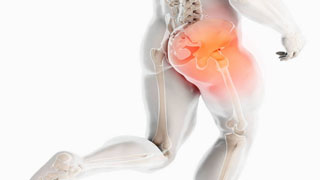
The gluteal muscles are the largest and strongest muscle group in the body. However, they usually do not receive the same attention as muscles suitable for mirrors such as biceps or shoulders.
Many people believe that being able to squat deeply is enough to prove that their buttocks are in optimal shape. This article will make you reconsider this assumption.
Your hips perform six exercises, including:
Internal rotation, external rotation, abduction, adduction, flexion, expansion
You should be able to complete all six actions in perfect form. The issues in these six modes negate your claim of a healthy and fully functional buttocks.
This article discusses the causes of hip stiffness and the best exercise methods.
What is hip internal rotation?
Hip internal rotation involves twisting the thigh inward from the hip joint. You can perform hip internal rotation while sitting or standing.
There are three ways to achieve this:
Sit straight in a chair with your feet on the floor. Rotate your knees inward and feel the stretch of your adductor muscles.
Sit straight in the chair and stretch your legs straight in front of you. Rotate the legs and feet towards the midline of the body.
Stand upright with a torso that is shoulder width apart. Place your right foot in front of you, without bending your knees. Turn your body to the right.
Want to check if your hip rotator cuff is in optimal condition? Try these three methods. Feeling pain or stiffness when rotating the toes towards the midline of the body is a sign of a problem with the hip rotator cuff.
Exercises like squats require the use of hip internal rotation muscles. They are also used for daily activities such as walking, running, squatting, or crawling. When balancing the body with one leg, the internal rotator of the hip also participates.
Internal rotation of the hip joint activates several muscles in the hip, buttocks, and thighs. This includes the following:
The parts of the adductor longus, adductor brevis, adductor maximus, pubis, fascia lata, gluteus medius, and gluteus medius
Insufficient hip internal rotation can lead to impaired range of motion. The limited rotational range of motion of the hip joint can affect your performance in exercises such as squats, lunges, and hard pulls. In addition, it will also affect the efficiency of your daily work.
If you encounter difficulty rotating your thigh bone inward, there is no need to lower your head. The most outstanding among us will encounter situations of poor biomechanics. The good news is that it can be repaired.
Which muscles can cause hip external rotation?
Before starting the practice, let's deal with some internal affairs first. In this section, we will identify the hip external rotation muscles and demonstrate what a healthy range of hip external motion (ROM) looks like.
Hip external rotation muscle
There are many muscles involved in hip external rotation. The muscle movements in the body are extremely complex, and there is no muscle that only does one thing. On the contrary, muscles work together to promote healthy movement and function.
In terms of hip external rotation, well-known large muscles such as the gluteus maximus, gluteus medius, and gluteus medius are involved. A group of lesser known muscles known as "Deep Six" also participated. Deep 6 "are six small muscles on the outer side of the hip that contribute significantly to hip rotation.
Finally, although not usually mentioned, the hip flexors also make a significant contribution to hip external rotation. The iliopsoas muscle, sartorius muscle, TFL, and other high hip flexors help bend the hip during external rotation.
Every movement of the body is promoted by the coordinated and balanced work of many muscles. That's why it's difficult to attribute poor function in a specific exercise pattern to one or two muscles. This was perfectly demonstrated in the hip external rotation ROM test in the next section.
Reasons for poor internal rotation of hip joint
Restricted internal rotation of the hip joint is not always caused by injury. Limited hip internal rotation may occur unnoticed by you.
Do you want to know what to pay attention to? The following are some common causes of hip joint malrotation:
1. Hip impact
Hip impact is the compression of the hip socket (hip cup) by the femoral head. It can cause stiffness and pain in the buttocks, and may lead to arthritis.
Abnormal shape of the femur usually leads to hip impact. This situation is more common among young people who engage in activities that require significant twisting of the hips and sudden changes in direction. Accepting surgery is the only way to solve this problem.
2. Sedentary lifestyle
An inactive lifestyle is the root cause of many health problems (both mental and physical). Most of us spend most of our time bending over and sitting in front of computer screens or phones.
Sitting for a long time can overload our buttocks, leading to stiffness and loss of mobility. Office workers should leave their chairs for at least 10 minutes per hour.
Subtle lifestyle changes, such as taking stairs as much as possible. When you must use a mobile phone, please move around in the office or at home. Add toe contact to enhance your flexibility.
3. Poor posture
Poor posture is usually caused by an inactive lifestyle. People with hunchbacks and rounded shoulders are more likely to experience poor hip mobility.
Poor posture can overload the buttocks and cause stiffness and pain. Always pay attention to your posture, and take corrective measures immediately if you feel lethargic.
4. Muscle strain
Overwork of the hip rotator cuff can also lead to muscle stiffness. The hip rotator cuff is a small muscle group. You don't need to exercise more than once a week to train them.
You should also give your lower body at least 48 hours of recovery time between each workout. Doing too much without proper rest may backfire.
5. Osteoarthritis
Osteoarthritis (OA) is the most common joint disease and form of arthritis. When the protective cartilage at the buffering bone end wears away, osteoarthritis occurs. This degenerative joint disease typically affects your hands, knees, hips, and spinal joints. The joint damage caused by OA cannot be reversed.
6. Rotor bursitis
This is inflammation of the greater trochanter (a part of the buttocks) and bursa (a fluid filled sac near the joint). This chronic pain can affect the outer area of the buttocks or the outer part of the thighs, from the buttocks to the knees, along the thighs. The treatment methods for bursitis include ice packs, anti-inflammatory drugs, steroid injections, and physical therapy.
Treatment of insufficient internal rotation of hip joint
The treatment of hip malrotation depends on the cause and symptoms. If you encounter problems caused by muscle inflammation, your doctor may recommend taking medication. If a sedentary lifestyle, poor posture, or muscle strain is the culprit, physical therapy can be helpful.
8 for hip internal rotation disorders
Practice and stretching exercises
The tensor fascia lata, gluteus maximus, adductor longus, brevis, maximus, pubis, and piriformis muscles cause internal rotation of the hip joint. The exercises mentioned below will exercise these muscles.
1. Hip wiper
Steps:
Sit straight on the floor.
Place your feet flat on the floor in front of you, as far apart as possible.
Slowly tilt your knees to the right while keeping your torso upright.
At the highest point of the movement, your right thigh should align with your buttocks. Your right calf should be perpendicular to your quadriceps muscle. At the same time, the left thigh should be aligned with the torso, and the lower leg should be perpendicular to it.
Return to the starting position.
Repeat on the left side.
Alternate the number of recommendations on both sides.
Professional tip: If your knees are not touching the floor, don't worry. It requires practice and flexibility, and will be achieved over time.
2. Stand up, swing your legs, and swing
Steps:
Stand in a posture that is shoulder width apart.
Place your hands on your hips.
Bend your knees and lift your right leg towards the ceiling. At the top, your thighs should be parallel to the floor and your calves should be perpendicular.
While keeping the right knee fixed, swing the calf to both sides like a pendulum. Feel the stretching of the hip internal and external rotation muscles.
The number of times to repeat the recommendation before changing sides.
Professional tip: Ensure that your shoulders, chest, and hips are square throughout the entire practice process. During the pendulum swing, do not tilt the pelvis to one side.
3. Flip up style
Steps:
Lying on the exercise mat, legs folded, knees bent at a 45 degree angle.
Place your head on your lower arm and your upper arm on your hips.
Fold the hip bones together.
Keep your feet in contact, lift your knees as high as possible, and do not move your hips or pelvis.
Pause at the top and contract the hips.
Slowly return to the starting position.
Repeat the above operation for the recommended representative.
Professional tip: If the self weight version of this exercise feels too easy, please tie a resistance band around your knee.
4. Fire hydrant with toes
Steps:
Starting from the desktop position, place your hands under your shoulders and your knees under your hips.
Lift the left leg off the body at a 45 degree angle, but do not stretch the knee.
At the highest point where the knee is lifted, rotate the right thigh outward to the ceiling and place the foot on the floor.
Return to the starting position.
The number of times to repeat the recommendation before changing sides.
Professional tip: Keep your head and torso in a neutral position throughout the entire practice process. Looking forward will strain your neck, while arching your back will reduce the tension on your hips.
5. Raise your legs 90-90
Steps:
Sitting on the floor with knees in a "90-90" or "windmill" position.
Sit up straight and place your hands on the floor for support.
Lift the front legs towards the ceiling while keeping the knees and ankles in a straight line.
Repeat ten times.
Now, lean forward slightly to lift your hind legs.
Lift your hind legs towards the ceiling while keeping your knees in a straight line.
Repeat ten times. Change sides.
Professional tip: Keep your torso upright as much as possible throughout the entire practice process. Tilting to one side makes the movement easier.
6. Lateral hip sliding
Steps:
Enter the desktop position and approach a sturdy object.
Wrap one end of the resistance band around the object and the other end around the top of the right leg.
Adjust your position so that the resistance band is perpendicular to your torso.
The elastic band should be tightened at the starting position so that it pulls your leg outward.
Slide back and forth to apply greater tension to the hip rotator cuff.
Repeat on the other side.
Professional tip: Maintain a slow and controlled sliding motion to feel the optimal extension of the buttocks.
7. Hip rotation in sitting position
Steps:
Sit upright on a high platform, with legs bent 90 degrees and feet flat on the floor.
Move your right foot outward and upward as much as possible to maintain knee stability.
Return to the starting position. Repeat 20 to 30 times. Repeat the above action with the left leg.
Professional tip: When performing this exercise, tying a resistance band around the ankle can help better recruit the hip rotator muscles.
8. Internal rotation of hip joint in sitting position
Steps:
Sit straight on the floor.
Bend your knees 90 degrees and place your heels on the floor.
Place your hands behind your back for support.
Slowly bend your right knee towards the midline of your body and bring it as close to the floor as possible.
Hold for three seconds, then return to the starting position.
The number of times to repeat the recommendation before changing sides.
Professional tip: Keep the trunk upright throughout the entire exercise process for optimal hip internal rotation muscle stimulation.
How often should I perform hip internal rotation exercises?
Unless you have hip range of motion issues, you don't need to spend the entire workout on hip internal rotation. Add 1-2 hip rotation exercises to your regular exercise routine to maintain hip health.
summary
Don't wait until you lose your mobility to start hip internal rotation exercises. Perform the exercises mentioned in this article once a week to improve functionality and reduce the risk of injury.
If you are facing mobility issues, you should perform 2-3 hip internal rotation exercises per week. Maintain patience and consistency; Improvement may take 8-12 weeks. Good luck!


